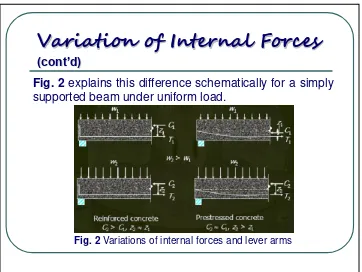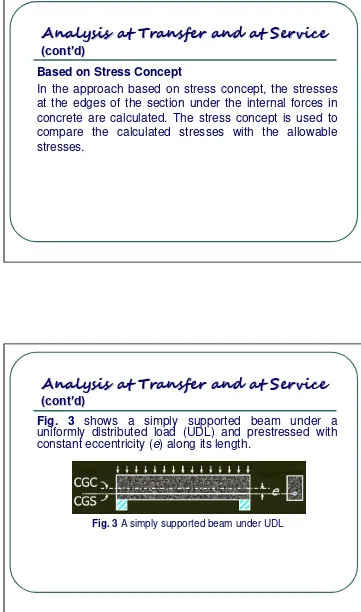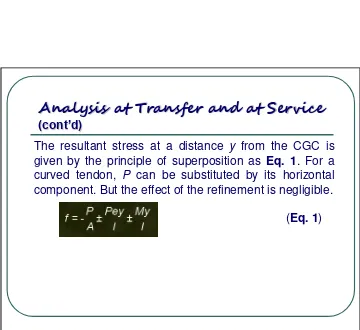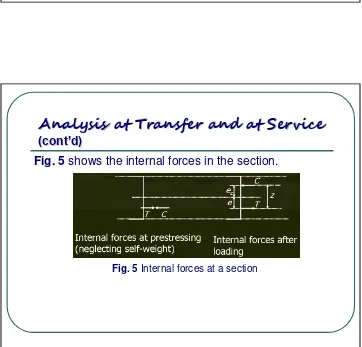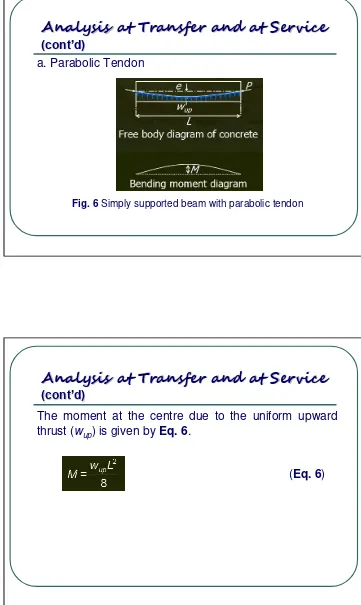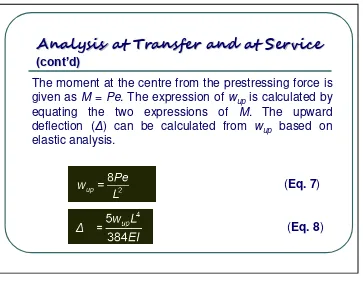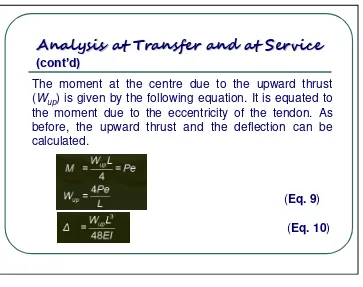Dr.Eng. Achfas Zacoeb, ST., MT.
The analysis of members refers to the evaluation of the following conditions:
1.Permissible prestress based on allowable stresses at
transfer.
2.Stresses under service loads. These are compared
with allowable stresses under service conditions.
3.Ultimate strength. This is compared with the demand
under factored loads.
Introduction
(cont’d)
The analysis of members under flexure considers the following assumptions:
1. Plane sections remain plane untill failure (known as
Bernoulli’s hypothesis).
2. Perfect bond between concrete and prestressing
steel for bonded tendons.
Introduction
(cont’d)
The analysis of behavior involves three principles of mechanics:
1. Equilibrium of internal forces with the external
loads. The compression in concrete (C) is equal to
the tension in the tendon (T). The couple of C and
Introduction
(cont’d)
2. Compatibility of the strains in concrete and in steel for bonded tendons. The formulation also involves the assumption of plane section remaining plane after bending and a perfect bond between the two materials. For unbonded tendons, the compatibility is in terms of total deformation.
3. Constitutive relationships relating the stresses and the strains in the materials. The relationships are developed based on the material properties.
(Collins & Mitchell, Prestressed Concrete Structures)
Variation of Internal Forces
In reinforced concrete members under flexure, the
values of compression in concrete (C) and tension in the
steel (T) increase with increasing external load. The
change in the lever arm (z) is not large.
In prestressed concrete members under flexure, at
transfer of prestress C is located close to T. The couple
of C and T balance only the self weight. At service loads,
C shifts up and the lever arm (z) gets large. The
Variation of Internal Forces
(cont’d)
Fig. 2 explains this difference schematically for a simply supported beam under uniform load.
Fig. 2 Variations of internal forces and lever arms
Analysis at Transfer and at Service
The analyses at transfer and under service loads are similar. Hence, they are presented together. A prestressed member usually remains uncracked under service loads. The concrete and steel are treated as elastic materials. The principle of superposition is applied. The increase in stress in the prestressing steel due to bending is neglected.
Analysis at Transfer and at Service
(cont’d)
There are three approaches to analyse a prestressed member at transfer and under service loads. These approaches are based on the following concepts:
a. Based on stress concept.
b. Based on force concept.
Analysis at Transfer and at Service
(cont’d)
Based on Stress Concept
In the approach based on stress concept, the stresses at the edges of the section under the internal forces in concrete are calculated. The stress concept is used to compare the calculated stresses with the allowable stresses.
Analysis at Transfer and at Service
(cont’d)
Fig. 3 shows a simply supported beam under a uniformly distributed load (UDL) and prestressed with
constant eccentricity (e) along its length.
Analysis at Transfer and at Service
(cont’d)
Fig. 4 shows the internal forces in concrete at a section and the corresponding stress profiles. The first stress is
due to the compression P, the second is due to the
eccentricity of the compression, and the third is due to the moment. The moment is due to self weight at transfer, and due to service loads at service.
Fig. 4 Stress profiles at a section due to internal forces
Analysis at Transfer and at Service
(cont’d)
The resultant stress at a distance y from the CGC is
given by the principle of superposition as Eq. 1. For a
curved tendon, P can be substituted by its horizontal
component. But the effect of the refinement is negligible.
Analysis at Transfer and at Service
(cont’d)
Based on Force Concept
The approach based on force concept is analogous to capacity. Of course, the stresses in concrete calculated by this approach are same as those calculated based on stress concept. The stresses at the extreme edges are compared with the allowable stresses.
Analysis at Transfer and at Service
(cont’d)
Fig. 5 shows the internal forces in the section.
Analysis at Transfer and at Service
(cont’d)
The equilibrium equations are as follows:
(Eq. 2)
(Eq. 3)
Analysis at Transfer and at Service
Analysis at Transfer and at Service
(cont’d)
Based on Load Balancing Concept
The approach based on load balancing concept is used for a member with curved or harped tendons and in the analysis of indeterminate continuous beams. The moment, upward thrust and upward deflection (camber) due to the prestress in the tendons are calculated. The upward thrust balances part of the superimposed load.
Analysis at Transfer and at Service
(cont’d)
The expressions for three profiles of tendons in simply supported beams are give such as:
a. For a Parabolic Tendon
b. For Singly Harped Tendon
Analysis at Transfer and at Service
(cont’d)
a. Parabolic Tendon
Fig. 6 Simply supported beam with parabolic tendon
Analysis at Transfer and at Service
(cont’d)
The moment at the centre due to the uniform upward thrust (wup) is given by Eq. 6.
Analysis at Transfer and at Service
(cont’d)
The moment at the centre from the prestressing force is
given as M = Pe. The expression of wup is calculated by
Analysis at Transfer and at Service
(cont’d)
b. Singly Harped Tendon
Analysis at Transfer and at Service
(cont’d)
The moment at the centre due to the upward thrust
(Wup) is given by the following equation. It is equated to
the moment due to the eccentricity of the tendon. As before, the upward thrust and the deflection can be calculated.
(Eq. 9)
(Eq. 10)
Analysis at Transfer and at Service
(cont’d)
Analysis at Transfer and at Service
(cont’d)
The moment at the centre due to the upward thrusts
(Wup) is given by the following equation. It is equated to
the moment due to the eccentricity of the tendon. As
Solution
a. Stress concept Area of concrete,
Moment of inertia,
Bending moment at mid-span,
Solution
(cont’d)
Top fibre stress,
Solution
(cont’d)
b. Force concept
Applied moment,
Lever arm,
Solution
(cont’d)
Eccentricity of C,
Solution
(cont’d)
Bottom fibre stress,
Solution
(cont’d)
c. Load balancing method
Effective upward load,
Residual load,
Solution
(cont’d)
Residual bending stress,
Top fibre stress,
Solution
(cont’d)
Bottom fibre stress,
The resultant stress
